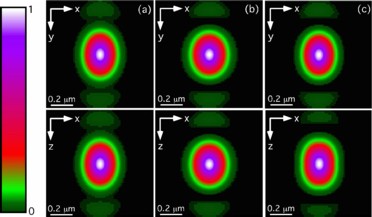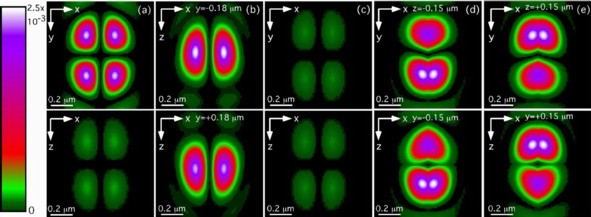I work on optical properties of imaging systems, more specifically
on the microscope (with all variants). Several image formation models
exist. One can then compute the Point Spread Function of the microscope,
which characterizes its resolution (left picture). Every modelisation
is based on a model and relies on the knowledge of some parameters,
which may differ from their actual values, leading to important differences
between computation and experiments:
|
|
|
|
(2-D xy and xz cuts) |
(2-D xy and xz cuts) |
Some parameters of the model are easy to measure (thickness and index of the coverslip for exemple), but other are very difficult or even impossible to measure in pratice, as the depth of the specimen under the coverslip, the immersion oil index of refraction (which may vary with temperature), or the effective numerical aperture of the objective.
I have shown that it is possible to recover these parameters from a measure of the PSF [1] . This result is important for biologist using microscopes, helping them to precise the experimental protocol of image acquisition. Moreover, one can then use for deconvolution of the image a computed PSF which is noiseless and simultaneously as close as possible to the experimental PSF.
One can then use in better conditions the deconvolution algorithms, which are the second topic of the lab. The acquired images suffer from blurring and noise. Deconvolution can (partially) restore the images and correct these defects.
We work to improve the algorithms by the automation of the procedure and measurements [2][3].
My work has also lead me to propose a new concept of high resolution
microscopy, called Multiple Objective Microscopy (MOM) [4]. Combining 4Pi and Theta
microscopy, it is possible to achieve a very high resolution (100 nm laterally
and axially) using low numeriacal aperture (0.8) objectives.
This result is important because:
- from a theoretical point of view, it shows that high resolution
is not restricted to high numerical aperture objectives
- in pratice, it should be possible to study large volumes (
of the order of 1mm3) with a very high resolution because
low NA objectives have long working distances.
|
objectives 1 to 4 are used to coherntly excite the specimen
|
top : lateral cut (xy) bottom
: axial cut (xz) |
If fixed molecules are considered, one must take into account the polarisation moment induced by the excitation PSF, and the reemited dipole field is polarised. The shape and intensity of the PSF then strongly depends on the considered observed polarisation (parallel ort crossed polars) [6]:

|
|
Point Spread Functions for a theta microscope
using water immersion objectives with NA=0.8,
excitation at l=400 nm and detection at l=450 nm (Cascade Blue – Molecular
Probes). (a) conventional unpolarized isotropic radiation model. (b-c) dipole
emission model. (b) x-polarized excitation, x-polarized detection. (c) z-polarized
excitation, x-polarized detection.
|

|
|
Point Spread Functions
as for above figure, but for y-polarized detection. (a) x-polarized excitation,
y-polarized detection. (b) same as (a)-bottom, but in the y=-0.18 mm and
y=+0.18 mm plane respectively. Note the assymetry. (c) z-polarized excitation,
y-polarized detection. (d-e) same as (c) but in the z=±0.15 mm and
y=±0.15 mm plane. Note the complex shape of the PSF in that case. |


